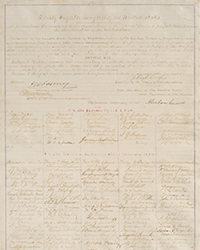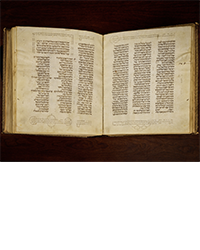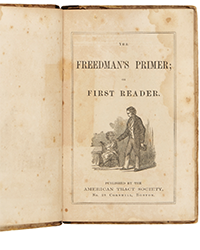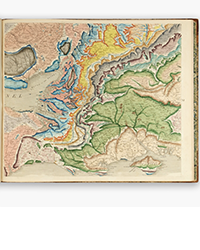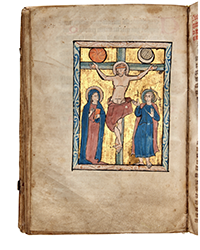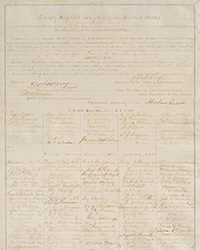Jonathan A. Hill Bookseller presents Catalogue 244. Chinese, Japanese, & Korean Books, Manuscripts, & Scrolls. This is a catalogue for collectors of the Far East, and presumably the most serious, both because of value and the understanding of these countries needed to fully appreciate this material. It is written in the native languages, and most are very old. The majority are manuscripts rather than printed books. I will admit that my knowledge of this material is, at best, superficial, if even, but hopefully this can bring some of these items to the attention of those who collect. If you do, you need to pick up a copy of Hill's catalogue as the descriptions are thorough and images are numerous.
One more note – there are many centuries-old items of illustrated, explicit Japanese erotica. I wouldn't expect there to be such material in America from that time. Evidently, the Japanese aren't as repressed as Americans. I haven't described this because...well...I'm a repressed American. It must be nice to be free from those old inhibitions. Here are a few of the other items in this collection.
There is a traditional celebration of spring in Japan known as the Festival of Seven Herbs. It must be early spring since it occurs on the seventh day of January. The tradition arrived from ancient China long ago. Seven different herbs are collected and cooked in a porridge. The herbs are parsley, cudweed, shepherd's purse, turnip, chickweed, nipplewort, and radish. They were said to promote good health, longevity, and good luck. There is a similar celebration in the fall, though not as extensive. Seven flowers are collected, but there is no porridge as they are not edible. Item 30 is Akino nanakusa ko (thoughts about seven herbs in autumn) along with Hanu nanakusa ko (thoughts about seven herbs in spring) from Kikuu Kitano, published in 1812 and 1814. Kitano established a large garden in Edo (now Tokyo) which survives to this day. Priced at $7,500.
When American Admiral Perry forced Japan to open its doors to trade with other nations in the 1850s, he left behind serious divisions within the country. Some wanted to cooperate with the West; others wanted to resist. The Shogun was in the former camp which led to opponents seeking to have the Emperor support traditional values and resist cooperation. The differences led to bloody battles in Kyoto. There were several years of chaos and violence, assassinations on the streets of Kyoto. Item 35 is a manuscript from 1862 or thereabouts describing events and persons assassinated. Most were supporters of the Shogun. Heads of victims of the killings are drawn with their heads on stakes or bodies on wracks. Their “crimes” are described next to them. It would only be a few years later, in 1868, that those opposed to the Shogun succeeded, ending centuries of de facto rule by the shogunate, restoring the Emperor to power, but by then it was too late to seal off Japan from the rest of the world again. $4,500.
Next is an antiquarian Chinese Sutra, the Yuanjue Canon, Juan (fascicle) number 6 (of 7). It was printed in the twelfth or thirteenth century. Hill being able to establish a date range between the 1110s and 1276. It was printed in China from woodblocks by Ge Fang, Ma Qing, and others. The sutras were written in India in ancient times. They reflect the teachings of the Buddha, who lived several centuries BCE. They are designed to lead you from bad behaviors to good ones, which in turn leads from suffering to a state of mental joy. They came to China as a result of a pilgrimage in 645 by Xuanzang. He brought them back to China, and with a team of helpers, translated them to Chinese. Item 55. $150,000.
This is a manuscript Hill describes as “the beginning of the banking system in Japan.” The title is Gyoyoshu (collection of details on rice brokers money lending). It consists of three volumes with a preface dated 1818. Hill explains that rice brokers in 18th century Japan became very wealthy. It wasn't so much from selling rice as lending money. Interest rates were high. They filled a role later filled by banks. In 1724, the rice brokers formed a guild. Quoting George Sanson's History of Japan 1615-1867, “The fudasashi as a class made outrageous profits and were notorious for their patronage of the most luxurious establishments in the pleasure quarters of Yedo. They were the most prominent and the most numerous of the great spendthrifts of the day.” This manuscript was written by guild member Sadatsugu Ogiya. It describes the original 109 members and their clients, information about the workings of the guild, interest rates and volumes of rice sold annually, day-to-day issues within the guild from 1795-1818, bribery and fraudulent activities, transportation of rice, issues with the shogunate, wages of warehouse workers, and much more. Item 44. $13,500.
Here is a manuscript you can use today. Its title is Kojin hasei roku (how to cultivate shiitake mushrooms). It contains three double page and three single-page paintings, all but one in color. The date would be late Edo (up to 1867) but the text was written earlier, by Awagimaru Hata, who lived 1764-1808. Demand outpaced growth in the wild, so growers would cut logs and lay them on the ground for three years. The mushrooms grow on rotting logs. The logs would be placed in a shaded area near other shiitake mushrooms that would then spread to the logs. After the mushrooms were harvested, they were placed on wooden skewers in front of charcoal fires. This manuscript recounts the history of mushroom-growing and provides instructions on how to grow them. Item 53. $3,500.
Jonathan A. Hill Bookseller may be reached at 646-827-0724 or jonathan@jonathanahill.com. The website is www.jonathanahill.com.


